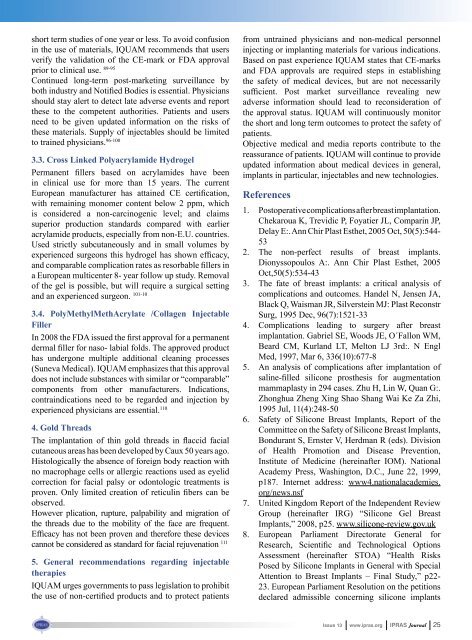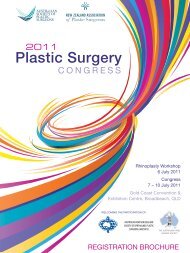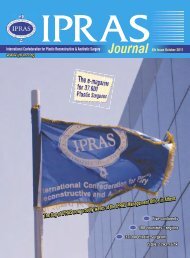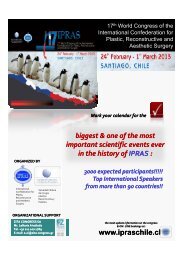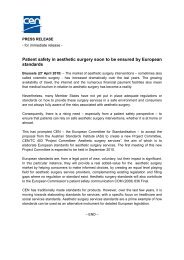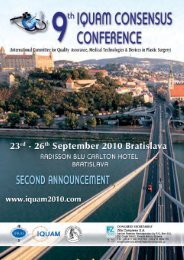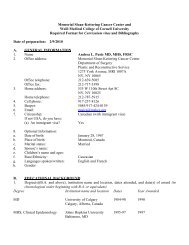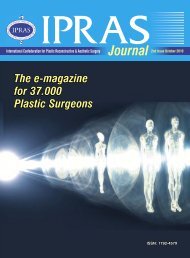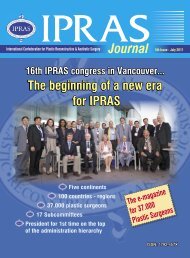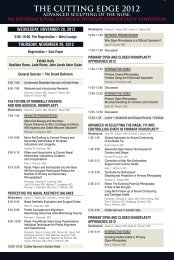Download pdf file - Ipras
Download pdf file - Ipras
Download pdf file - Ipras
You also want an ePaper? Increase the reach of your titles
YUMPU automatically turns print PDFs into web optimized ePapers that Google loves.
short term studies of one year or less. To avoid confusion<br />
in the use of materials, IQUAM recommends that users<br />
verify the validation of the CE-mark or FDA approval<br />
prior to clinical use. 89-95<br />
Continued long-term post-marketing surveillance by<br />
both industry and Notified Bodies is essential. Physicians<br />
should stay alert to detect late adverse events and report<br />
these to the competent authorities. Patients and users<br />
need to be given updated information on the risks of<br />
these materials. Supply of injectables should be limited<br />
to trained physicians. 96-100<br />
3.3. Cross Linked Polyacrylamide Hydrogel<br />
Permanent fillers based on acrylamides have been<br />
in clinical use for more than 15 years. The current<br />
European manufacturer has attained CE certification,<br />
with remaining monomer content below 2 ppm, which<br />
is considered a non-carcinogenic level; and claims<br />
superior production standards compared with earlier<br />
acrylamide products, especially from non-E.U. countries.<br />
Used strictly subcutaneously and in small volumes by<br />
experienced surgeons this hydrogel has shown efficacy,<br />
and comparable complication rates as resorbable fillers in<br />
a European multicenter 8- year follow up study. Removal<br />
of the gel is possible, but will require a surgical setting<br />
and an experienced surgeon. 101-10<br />
3.4. PolyMethylMethAcrylate /Collagen Injectable<br />
Filler<br />
In 2008 the FDA issued the first approval for a permanent<br />
dermal filler for naso- labial folds. The approved product<br />
has undergone multiple additional cleaning processes<br />
(Suneva Medical). IQUAM emphasizes that this approval<br />
does not include substances with similar or “comparable”<br />
components from other manufacturers. Indications,<br />
contraindications need to be regarded and injection by<br />
experienced physicians are essential. 110<br />
4. Gold Threads<br />
The implantation of thin gold threads in flaccid facial<br />
cutaneous areas has been developed by Caux 50 years ago.<br />
Histologically the absence of foreign body reaction with<br />
no macrophage cells or allergic reactions used as eyelid<br />
correction for facial palsy or odontologic treatments is<br />
proven. Only limited creation of reticulin fibers can be<br />
observed.<br />
However plication, rupture, palpability and migration of<br />
the threads due to the mobility of the face are frequent.<br />
Efficacy has not been proven and therefore these devices<br />
cannot be considered as standard for facial rejuvenation 111<br />
5. General recommendations regarding injectable<br />
therapies<br />
IQUAM urges governments to pass legislation to prohibit<br />
the use of non-certified products and to protect patients<br />
from untrained physicians and non-medical personnel<br />
injecting or implanting materials for various indications.<br />
Based on past experience IQUAM states that CE-marks<br />
and FDA approvals are required steps in establishing<br />
the safety of medical devices, but are not necessarily<br />
sufficient. Post market surveillance revealing new<br />
adverse information should lead to reconsideration of<br />
the approval status. IQUAM will continuously monitor<br />
the short and long term outcomes to protect the safety of<br />
patients.<br />
Objective medical and media reports contribute to the<br />
reassurance of patients. IQUAM will continue to provide<br />
updated information about medical devices in general,<br />
implants in particular, injectables and new technologies.<br />
References<br />
1. Postoperative complications after breast implantation.<br />
Chekaroua K, Trevidic P, Foyatier JL, Comparin JP,<br />
Delay E:. Ann Chir Plast Esthet, 2005 Oct, 50(5):544-<br />
53<br />
2. The non-perfect results of breast implants.<br />
Dionyssopoulos A:. Ann Chir Plast Esthet, 2005<br />
Oct,50(5):534-43<br />
3. The fate of breast implants: a critical analysis of<br />
complications and outcomes. Handel N, Jensen JA,<br />
Black Q, Waisman JR, Silverstein MJ: Plast Reconstr<br />
Surg, 1995 Dec, 96(7):1521-33<br />
4. Complications leading to surgery after breast<br />
implantation. Gabriel SE, Woods JE, O´Fallon WM,<br />
Beard CM, Kurland LT, Melton LJ 3rd:. N Engl<br />
Med, 1997, Mar 6, 336(10):677-8<br />
5. An analysis of complications after implantation of<br />
saline-filled silicone prosthesis for augmentation<br />
mammaplasty in 294 cases. Zhu H, Lin W, Quan G:.<br />
Zhonghua Zheng Xing Shao Shang Wai Ke Za Zhi,<br />
1995 Jul, 11(4):248-50<br />
6. Safety of Silicone Breast Implants, Report of the<br />
Committee on the Safety of Silicone Breast Implants,<br />
Bondurant S, Ernster V, Herdman R (eds). Division<br />
of Health Promotion and Disease Prevention,<br />
Institute of Medicine (hereinafter IOM). National<br />
Academy Press, Washington, D.C., June 22, 1999,<br />
p187. Internet address: www4.nationalacademies.<br />
org/news.nsf<br />
7. United Kingdom Report of the Independent Review<br />
Group (hereinafter IRG) “Silicone Gel Breast<br />
Implants,” 2008, p25. www.silicone-review.gov.uk<br />
8. European Parliament Directorate General for<br />
Research, Scientific and Technological Options<br />
Assessment (hereinafter STOA) “Health Risks<br />
Posed by Silicone Implants in General with Special<br />
Attention to Breast Implants – Final Study,” p22-<br />
23. European Parliament Resolution on the petitions<br />
declared admissible concerning silicone implants<br />
Issue 13 www.ipras.org IPRAS Journal 25


